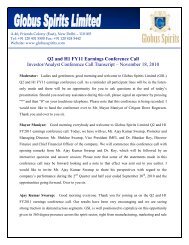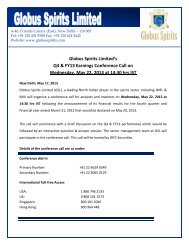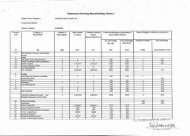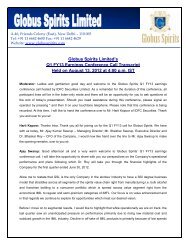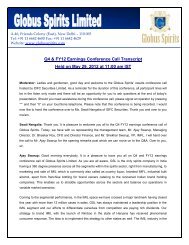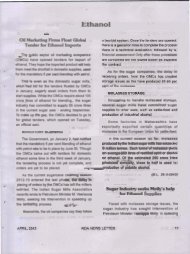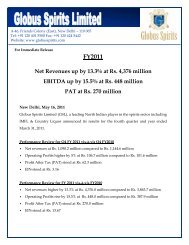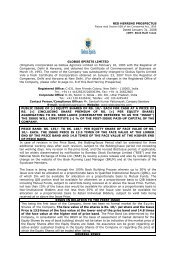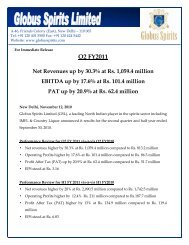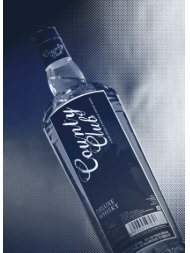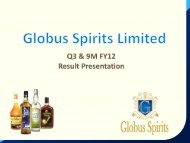RED HERRING PROSPECTUS Dated August 24 ... - Globus Spirits
RED HERRING PROSPECTUS Dated August 24 ... - Globus Spirits
RED HERRING PROSPECTUS Dated August 24 ... - Globus Spirits
You also want an ePaper? Increase the reach of your titles
YUMPU automatically turns print PDFs into web optimized ePapers that Google loves.
In India alcohol is largely produced from sugarcane molasses. The industry is cyclical in nature,<br />
as sugarcane production itself is affected every 3-4 years with monsoon and other factors,<br />
resulting in low availability of molasses. (Source: Financial Appraisal Report of SBI dated<br />
September 5, 2008)<br />
Industrial Alcohol is a source of raw material for various alcohol-based chemical industries and is<br />
used in manufacture of ethyl acetate, mono ethylene glycol, acetic acid, various esters and<br />
pesticides. It also finds extensive use in the pharmaceutical and paints industry. There is a huge<br />
demand for these products in the market.<br />
Liquor industry is unique as there are certain key variable factors that influence its viability and<br />
growth such as duty structures, excise rules and regulations, product-pricing, marketing<br />
initiatives to promote the brand, distribution and several regulatory issues like licenses to<br />
manufacture, labelling etc. On issues of excise and duties, these are fast coming to World Trade<br />
Organization (WTO) levels. The industry does not have many entry barriers and with the opening<br />
up of the economy there are multiple ways of market entry; it could be Bottled in India (BII) or<br />
Bottled in Origin (BIO) or Bulk Import and locally bottled. While this will enable world-class<br />
quality brands to enter India, there is a fear that the stagnating markets overseas may trigger<br />
dumping of cheap liquor into the Indian market, which will not be a healthy trend for both the<br />
Indian consumer as well as the domestic liquor players.<br />
Taxation being a major contributing factor to the increase in the price at the consumer level, the<br />
trend to go in for cheaper products in key whisky and rum segment has been on the increase of<br />
late. The lower category whisky segment has been growing rapidly in recent years.<br />
The lower per capita consumption in India, the high volume in the unorganized cheap segment<br />
of the spirits business with its likely transition into the organized sector, the changing consumer<br />
perception of alcohol and the progressive regulatory changes are the key drivers to the growth<br />
of this industry.<br />
The IMFL market primarily comprising of Whisky, Rum, Brandy, Gin and Vodka, has grown over<br />
the past decade.<br />
The IMFL industry in India is estimated at over 160 million cases and is growing steadily.<br />
Consumption is largely skewed towards whisky, which accounts for more than half of the<br />
market. The whisky segment is further classified into Scotch, Super Premium, Premium,<br />
Prestige/Deluxe, Regular, Medium and Cheap segment. Brandy, Rum and Whites (Gin, Vodka<br />
and others) account for the balance.<br />
The Country Liquor market is basically a regional market and there exist a large number of small<br />
manufacturers spread across various States. Major IMFL manufacturers, however, have a<br />
countrywide presence.<br />
Indian Market: Present Status & Products<br />
Currently the industry is dominated by 3 brewers, the United Breweries, Shaw Wallace and<br />
Mohan Meakins. However, a number of international brewers are starting to become established.<br />
Joint ventures will continue to be more important as the distribution network in India is complex.<br />
There are around 23,000 licensed liquor outlets in India, with another 10,000 outlets such as<br />
bars and restaurants. States vary as to their treatment of liquor and there are restrictions on the<br />
transfer of alcohol between states. In Tamil Nadu, Kerala and Andhra Pradesh the distribution is<br />
controlled by the state government, which enables changes in political parties to dramatically<br />
affect the availability of alcohol. In Andhra Pradesh a change of government resulted in a ban on<br />
the sale of alcohol in the state, while in Uttar Pradesh, Rajasthan and Punjab, liquor distribution<br />
licenses are auctioned to the highest bidder. Such a system encourages market concentration by<br />
favouring existing suppliers. Only in states such as Maharashtra, where distribution is relatively<br />
open, are new entrants able to compete effectively. Draught beer is popular in Mumbai and<br />
Bangalore and in these cities a large number of pubs and bars operate. (Source: Ministry of Food<br />
Processing Industries, Government of India; http://mofpi.nic.in/industryspecificinformation)<br />
Whisky and Other <strong>Spirits</strong><br />
In India Country Liquor and IMFL (Indian-Made Foreign Liquor) cater to two quite different<br />
sectors of the liquor market. Country liquor is consumed in rural areas and by low-income<br />
66




